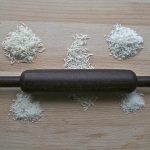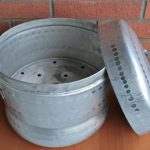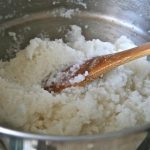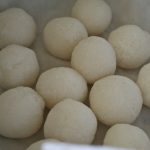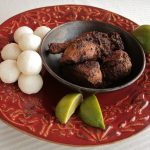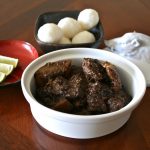In Coorg, as in most of South India, rice in some form is at at the heart of every meal. It never ceases to amaze me, just how creative cooks through the ages have been with a staple like rice.
The Kodava repertoire of rice based preparations is large, ranging from flatbreads to pulaos, pancakes to dumplings and more. And all those “puttus”. For the most part, a “puttu” is some form of steamed rice cake, savoury or sweet. But just to mix it up a little, there are several other kinds of preparations, fried, or made with roasted rice, that also carry the “puttu” tag!
Broken raw rice, known as thari, is used to make three of the most popular puttus, namely paputtu (broken rice, cooked with milk and coconut), nuuputtu (cooked broken rice pressed into noodles), and kadambuttu (steamed dumplings made from broken rice). The latter two use a finer grain of thari than is used for paputtu. If you don’t have access to suitable broken rice, it’s quite easy to make your own at home.
To make thari, take ¼ – ½ cup of raw rice at a time (sona masuri or basmati work well) and pulse in a food processor. The idea is to break the grains, not grind them, so don’t overload the container. The bits should look like large crystals of sugar – say 4 to 5 pieces per typical grain of basmati for paputtu and 5 to 7 or more for nuputtu and kadambuttu. Don’t worry about uneven bits, but sieve out any powder that’s likely to make your puttus sticky.
If you plan to make just enough thari for a single use, here’s a super easy way. Wash your rice thoroughly. If using basmati, there’s no need to soak it, but sona masuri can be soaked for about ten minutes. Drain the rice and spread it on a kitchen towel to dry. When the rice is dry to the touch and flows freely again, try pressing a few grains between your fingers. They should be brittle and break easily. Spread the rice in a single layer on a chopping board and crush gently with a rolling pin, holding the handles firm and pressing gently down on the rice with a slight scraping action, breaking it as evenly as possible.
Or
Proceed with the same food processor method as above, pulsing the grains carefully in short bursts until the grains are the desired size.The rice breaks much more easily, with less flying rice dust than the unsoaked version. Sift out any fine powder and proceed with your puttus.
If you don’t plan to use this thari immediately,do not store it in an airtight container since it contains moisture and will go mouldy. Spread it out on a platter, cover loosely with a cloth and store in a dry place until you’re ready to use it. One cup of rice will yield an equivalent amount of thari, though the volume may seem slightly larger because of the absorbed moisture.
Now you’re ready to make..
Kadambuttu
Soft, steamed rice balls – the perfect foil for a spicy pork curry.
- 2 cups thari, soaked for 20 minutes and drained
- 4 cups water
- A pinch of salt
Bring the water to a boil in a deep pan and add the thari and salt. Once the rice has begun to soften, lower the heat to medium and cook, stirring and scraping the bottom of the pan constantly. Cook the mixture to a firm dough (about 7 – 8 minutes) then remove from the heat and cover with a clean cloth to keep the steam in.
When the mixture has cooled enough to handle, form the dough into balls a little smaller than a golf ball (or smaller if you prefer!) and arrange in a chekala* or steamer lined with cheesecloth. Keep a bowl of warm water with a few drops of ghee in it handy to moisten your palms when forming the kadambuttus.
Steam on medium-high for approximately 20 minutes and remove from the heat. Allow to cool in the steamer.
Makes approximately16 to 18 pieces.
*A voluminous steamer, the chekala, or sekala, is an essential piece of equipment in a Coorg kitchen.A reasonable substitute is a large pressure cooker, used without the weight. A bamboo steamer will do as well, but the cooking may take a little longer.
Happy Kailpodh!

